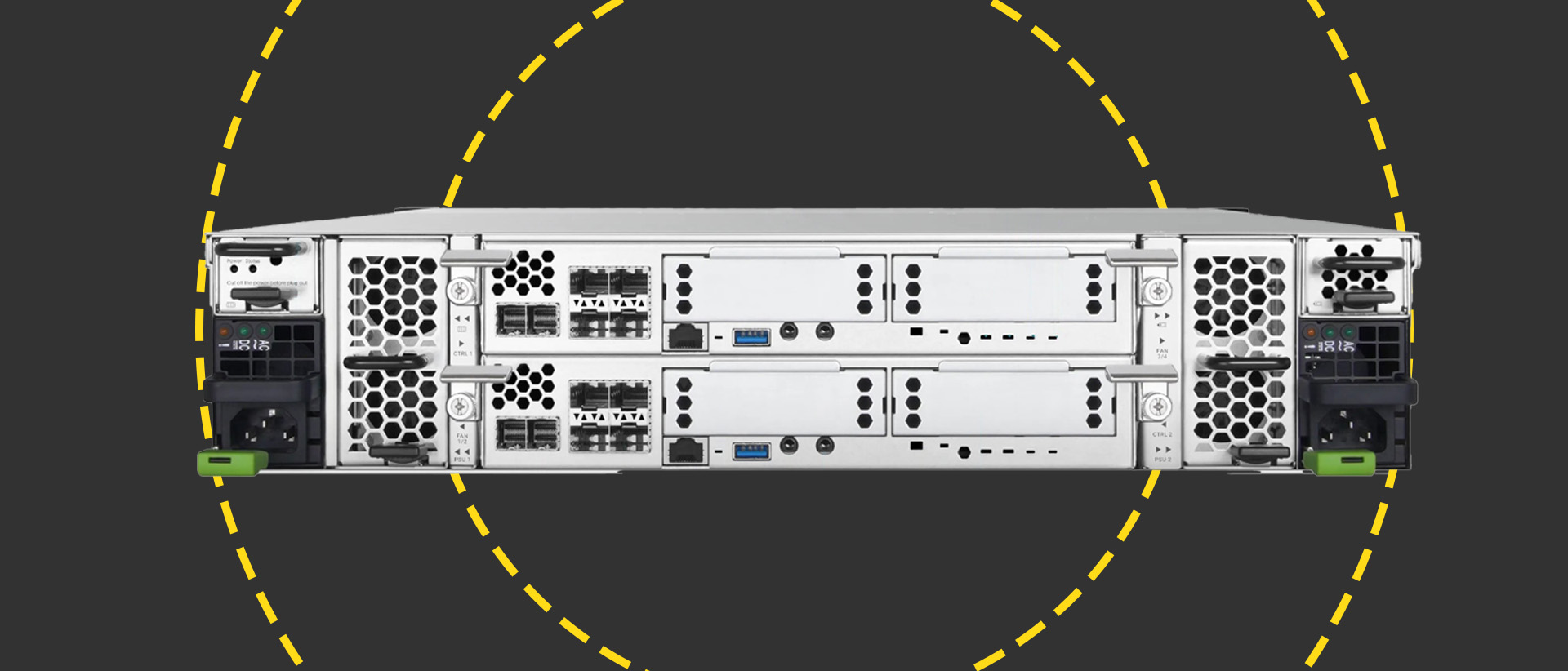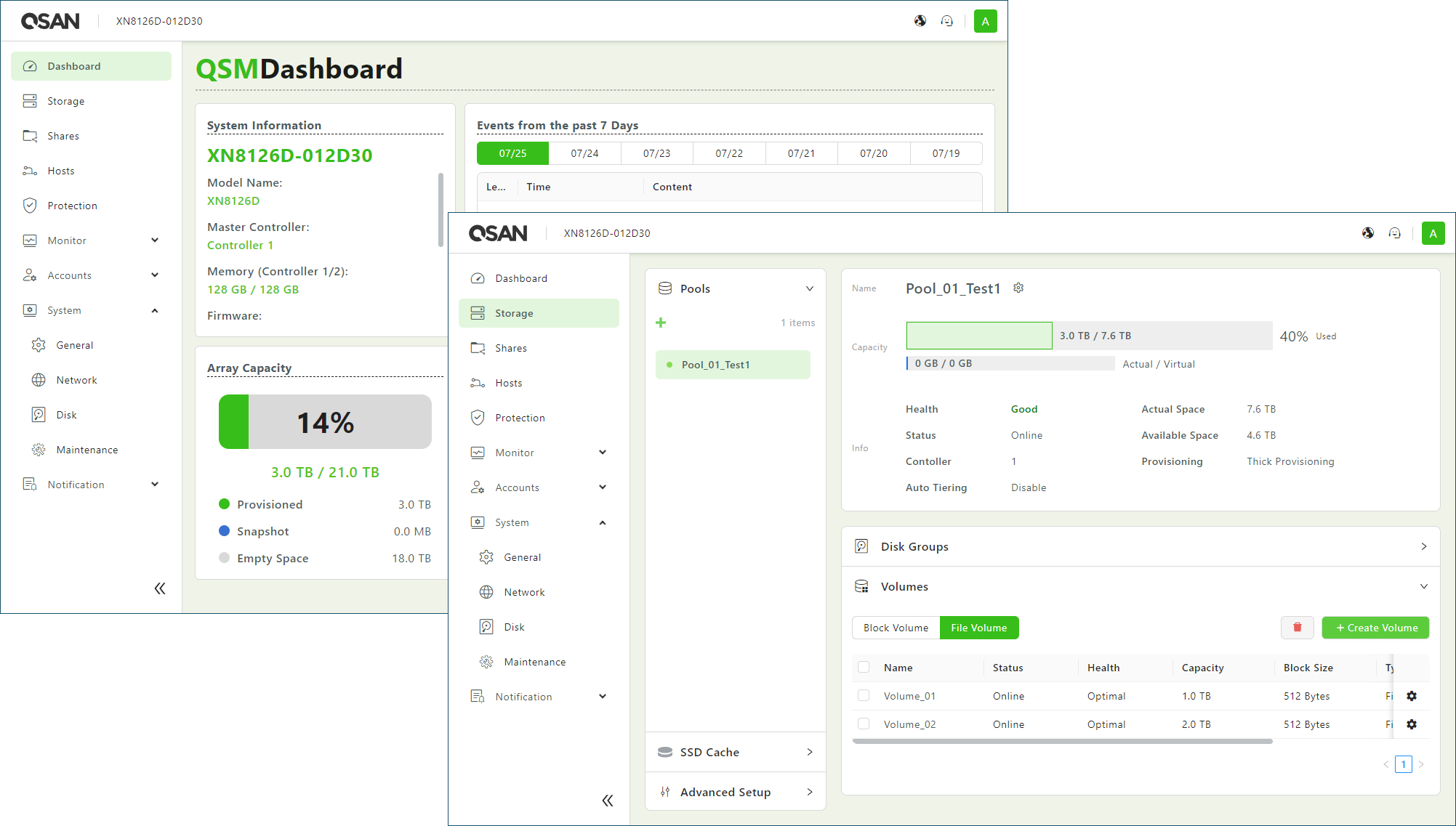Qsan XCubeNXT XN8126D review: Affordable fault-tolerant storage
A smart unified storage array offering end-to-end redundancy and a massive expansion potential

-
+
Good value
-
+
Active/active controllers
-
+
NAS
-
+
FC/IP SAN services
-
+
High port density
-
+
Enormous storage capacity
-
+
Fast NAS cluster failover
-
-
A number of QSM 4 features yet to be implemented

Qsan has a fine reputation for delivering affordable storage arrays and the XCubeNXT family takes this to the next level. Fault-tolerant FC and IP SANs have always been a top priority for Qsan but these new hybrid arrays add NAS share clustering services for all-round redundancy.
On review is the top-dog XN8126D which employs the same chassis as Qsan's XCubeSAN XS5326D appliance that claimed a world's first as the only one to put 26 SAS3 SFF bays in 2U of rack height. At the rear you'll find dual controllers running in active/active mode for fully transparent SAN failover.
Expansion is superb as the controllers have dual SAS3 ports and Qsan offers four disk shelves ranging from the 12-bay XD5312 to the 26-bay XD5326. The XN8126D supports a total of 546 drives allowing capacity to be pushed to an incredible 16.7PB.
Unlike most of the blue-chips, Qsan doesn't enforce vendor lock-in so you can choose pretty much any storage device you want. Qsan's partnership with Western Digital adds even more appeal as the XN8126D supports up to four of this vendor's supermassive UltraStar Data60 or Data120 JBODs.
Qsan XCubeNXT XN8126D review: Hardware components
Each controller comes with 16GB of DDR4 cache memory which can be field upgraded to 256GB. Our controllers are powered by eight-core Intel Xeon CPUs and a quick trip to their CLI over a serial port connection tells us these are 2.2GHz Xeon D-1735TR models.
Port choices are abundant as each controller includes integral Gigabit management and quad 10GbE SFP+ iSCSI data ports. Two module slots per controller are provided and Qsan offers dual RJ-45 10GbE iSCSI, quad 10GbE SFP+ iSCSI, dual or quad 16Gbps Fibre Channel (FC), dual 25GbE iSCSI and dual 32Gbps FC.
Hardware redundancy looks good as the controllers are supported by dual 850W hot-plug power supplies partnered by hot-plug fan modules located on each side. Qsan also offers optional cache protection modules that slot into dedicated bays above each PSU and come with M.2 flash memory and super-capacitors.
Qsan XCubeNXT XN8126D review: QSM 4 features
Qsan's XFinder app discovers the appliance on the network and provides a direct link to the QSM 4 web console. This OS has been created specifically for the XCubeNXT appliances and is very different to the QSM version used by Qsan's XCubeNAS models.
It bears more similarities with the XEVO OS used by the XCubeSAN models but its web console is devoid of any performance graphs for latency, IOPS, and throughput making it difficult to know how hard you're pushing the appliance. It's easy to use though, and your journey starts by configuring storage.
Our system was supplied with a full complement of 960GB Samsung PM1643a SAS3 SSDs and we used the wizard to choose drives, create storage pools, and decide on thick or thin provisioning, pool encryption, and auto tiering. RAID choices are extensive as along with all the usual suspects, you can select enhanced EE arrays which offer faster rebuild times by adding more spare drives to a pool.

When creating volumes, you choose the block option for FC and IP SAN presentation or file volumes for NAS shares. Snapshot protection can be applied to each volume and scheduled for as often as every five minutes.
Essential ransomware protection is present as WORM (write once, ready many) can be applied to file volumes. Unlike the QSM software for XCubeNAS, you don't have three policies to choose from and simply set a retention period in days, hours or minutes.
QSM 4 supports Rync backups with other compliant systems and in client mode, you can automatically send files to a remote system or retrieve them from it. Support for Qsan's XMirror service along with deduplication and compression aren't currently available but Qsan advised us they will be implemented in the next firmware version.
Qsan XCubeNXT XN8126D review: Clustering services
Qsan's clustering feature is designed to provide network link redundancy to NAS shares. It uses the same nominated Ethernet interface on each controller and assigns a virtual IP address to them.
For FC and IP SAN fault tolerance, you apply the standard method of connecting initiators to both controllers using MPIO. A valuable feature is the controllers' function in synchronous mode so hosts connected across both controllers have all MPIO links active and optimized.
Cluster creation is simple as you select the target interface on the controllers and assign a fixed IP address. Bandwidth for the two physical links is not aggregated as one link is active whilst the other remains on standby.
RELATED WHITEPAPER

The QSM 4 user manual doesn't mention this but you should ensure the IP addresses of the target interfaces are not on the same subnet as the cluster address to avoid potential conflicts. In practice, clustering works very well and to test this, we mapped a NAS share to a Dell PowerEdge Windows server using the cluster address assigned to a pair of 10GbE ports.
The web console showed Controller 1 was providing the primary link so we rebooted it from the QSM console while running a continuous Ping on the cluster IP address. We saw Ping timeouts while Controller 2 took over and in only 18 seconds, our NAS share was back in action.
Qsan XCubeNXT XN8126D review: Is it worth it?
Starting at under £11K for a diskless unit, the XCubeNXT XN8126D hybrid storage array is very competitively priced. The QSM 4 software makes light work of deployment but key features such as compression, deduplication, and system utilization stats have yet to be implemented.
That said, its active/active architecture delivers five 9s reliability and the cluster feature offers fast failover services for NAS shares. A great choice for mixed workloads, it provides a solid set of data protection features and an incredible storage potential.
Qsan XCubeNXT XN8126D specifications
| Chassis | 2U rack |
| Storage | 26 x SAS3 HDD/SSD SFF hot-swap bays |
| Power | 2 x 850W Platinum Plus hot-plug PSUs |
| Cooling | 2 x hot-plug dual-rotor fan modules |
| Controllers | Dual active/active controllers |
| CPU | 8-core 2.2GHz Intel Xeon D-1735TR |
| Memory | 16GB DDR4 ECC cache (max 256GB) |
| Cache protection | Optional cache to Flash module |
| Array support | RAID 0, 1, 10, 3, 5, 6, 10, 30, 50, 60, 5EE, 6EE, 50EE, 60EE |
| Ports | Gigabit management, 4 x 10GbE SFP+ iSCSI data ports, 2 x SAS3 expansion ports |
| Expansion bays | 2 module slots |
| Management | Web browser |
| Warranty | 5 year hardware, 1 year for Cache to Flash module |
Get the ITPro daily newsletter
Sign up today and you will receive a free copy of our Future Focus 2025 report - the leading guidance on AI, cybersecurity and other IT challenges as per 700+ senior executives
Dave is an IT consultant and freelance journalist specialising in hands-on reviews of computer networking products covering all market sectors from small businesses to enterprises. Founder of Binary Testing Ltd – the UK’s premier independent network testing laboratory - Dave has over 45 years of experience in the IT industry.
Dave has produced many thousands of in-depth business networking product reviews from his lab which have been reproduced globally. Writing for ITPro and its sister title, PC Pro, he covers all areas of business IT infrastructure, including servers, storage, network security, data protection, cloud, infrastructure and services.
-
 ‘Phishing kits are a force multiplier': Cheap cyber crime kits can be bought on the dark web for less than $25 – and experts warn it’s lowering the barrier of entry for amateur hackers
‘Phishing kits are a force multiplier': Cheap cyber crime kits can be bought on the dark web for less than $25 – and experts warn it’s lowering the barrier of entry for amateur hackersNews Research from NordVPN shows phishing kits are now widely available on the dark web and via messaging apps like Telegram, and are often selling for less than $25.
By Emma Woollacott Published
-
 Redis unveils new tools for developers working on AI applications
Redis unveils new tools for developers working on AI applicationsNews Redis has announced new tools aimed at making it easier for AI developers to build applications and optimize large language model (LLM) outputs.
By Ross Kelly Published
-
 Google layoffs continue with "hundreds" cut from Chrome, Android, and Pixel teams
Google layoffs continue with "hundreds" cut from Chrome, Android, and Pixel teamsNews The tech giant's efficiency drive enters a third year with devices teams the latest target
By Bobby Hellard Published